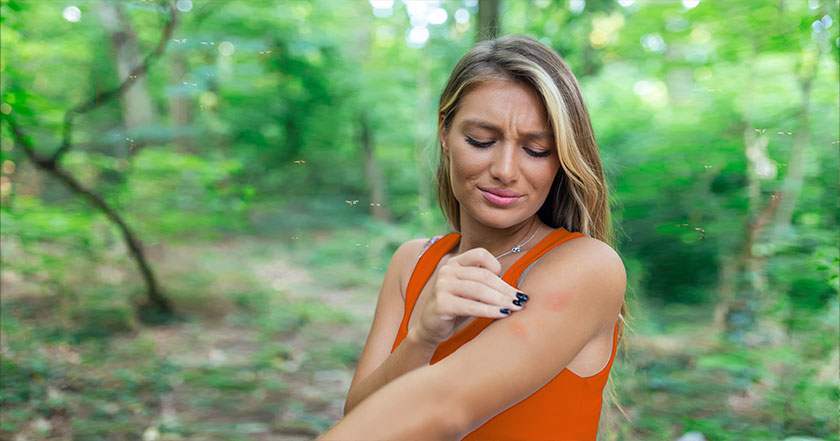
“Leaves of three, let them be.” This is a phrase you’ll want to remember if you enjoy spending time outdoors.
Poison ivy rash is the nation’s most common skin irritation, affecting more than 10 million Americans each year. The growth of poison ivy (along with poison oak and poison sumac) begins in the spring, causing a big spike in poison ivy cases every spring and summer.
First comes the itching, then the rash, then the blisters – poison ivy is not a fun experience, and certainly not one you want to share with others. Keep reading to learn what to do if you come in contact with poison ivy and how to stop it from spreading.
The plant oil found on the leaves and in the stems and roots of poison ivy is called urushiol. This oil can linger on virtually any surface for years (sometimes 10 years or more) until it’s washed off with water or rubbing alcohol. Urushiol is present in all plants in the Toxicodendron family, including poison ivy, poison oak, and poison sumac. Even dead plants can still have active urushiol on them.
After urushiol comes in contact with your skin, your symptoms will likely include itchiness, redness, swelling, and blisters. If you inhale smoke from burning poison ivy, you could also have difficulty breathing. There’s no doubt – urushiol is powerful stuff.
Let’s start with how it’s not spread first. Despite popular belief, poison ivy and other poisonous plant rashes are not contagious and do not spread from person to person. You also can’t spread a poison ivy rash to other parts of your body by scratching, showering, or sweating – the rash will only occur wherever urushiol touches your skin.
It may seem like your poison ivy rash is spreading over time, but there are a few possible explanations. Different parts of the body tend to absorb urushiol at different rates. You could also have urushiol trapped under your fingernails or continued exposure to contaminated objects. Even if your blisters break, the fluid inside them does not contain urushiol, so it cannot spread the rash any further.
So, how does poison ivy spread? By touching any part of the plant, of course. But urushiol can also be on clothing, shoes, gardening tools, camping equipment, or anything else that comes in contact with a poisonous plant. Even pets can spread poison ivy. Imagine this scenario: your dog walks through poison ivy, gets urushiol on its fur, you pet the dog, and boom. That’s how quickly and easily poison ivy can spread.
First and foremost, avoid touching objects where urushiol can be transmitted – and wash your hands right away if you do! You want to remove the oil from your skin as soon as possible. If you don’t have soap, use alcohol-based wipes instead. Don’t forget to wash under your fingernails to remove any urushiol that is trapped there.
Other ways to help stop the spread of poison ivy include:
After gardening or spending time outdoors in or near poison ivy, avoid touching your clothes with bare hands or letting them brush against your skin. Before removing your clothes, put on a pair of disposable rubber gloves. Place your clothes in a large plastic bag, then discard the gloves.
Be sure to dump the clothes directly into the washing machine so they do not touch outside, then discard the bag. Use the hottest water temperature that’s safe for the fabric and enough water to allow the clothes to agitate freely, plus high-quality laundry detergent.
To clean gardening tools, you can use rubbing alcohol or fill a bathtub with hot water and then add grease-cutting dish detergent. FYI: Lysol is not effective in removing urushiol from any objects.
Wash your pet as soon as possible after potential exposure (you’ll need to wear disposable rubber gloves for this as well). Use a poison ivy cleansing treatment (such as Tecnu®) or an anti-seborrheic or keratolytic shampoo for the best results.
These shampoos are most effective when used immediately, so it’s best to carry them with you if you and your furry friend are spending time in areas that might have poison ivy.
Poison ivy, poison oak, and poison sumac can be sprayed with glyphosate (also known as Roundup) to kill the plants. Remember that Roundup will kill any other vegetation it touches, so spray carefully. Wear long pants, long sleeves, boots, and gloves for extra protection – then follow the cleaning instructions listed above.
Diesel fuel can also kill poison ivy. However, bleach cannot. Never apply bleach to your skin, which can damage your skin tissues and make it harder for the rash to heal.
When you need relief from poison ivy or other painful rashes, vybe is here to help. If you come in contact with a poisonous plant, a vybe clinician can provide you with an evaluation and treatment plan.
If your poison ivy rash does not improve after a few weeks, is severe or widespread, continues to swell, or affects your eyes, mouth, or genitals, visit your nearest vybe right away. We may prescribe an oral corticosteroid.
vybe treats many types of illnesses and injuries, from poison ivy to pink eye. We also provide lab tests and screenings, vaccinations, physical exams, and much more.
All vybe clinics have licensed medical professionals with a wide range of healthcare knowledge. We’re open seven days a week with extended weekday hours. No appointment is necessary – just walk in!
FIND YOUR VYBE